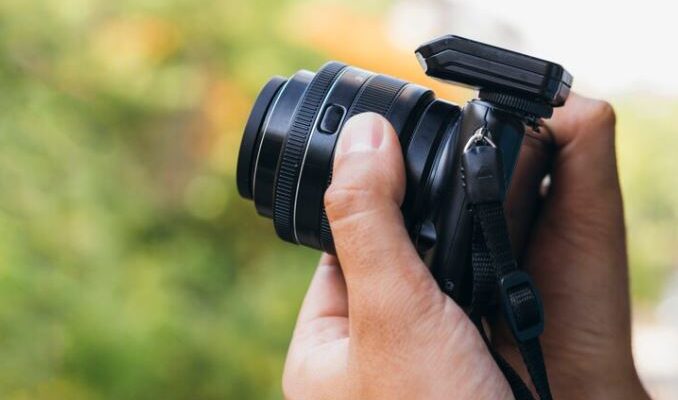Digital cameras have revolutionized the way we capture and share our lives. From family gatherings to professional photography, these devices offer unmatched versatility and quality. Whether you’re a beginner or a seasoned photographer, understanding digital cameras can help you choose the right equipment and improve your photography skills. This guide explores the essential aspects of digital cameras, their features, and how to make the most out of your investment.
What is a Digital Camera?
A digital camera is an electronic device that captures and stores photographs digitally instead of using traditional film. Unlike film cameras, digital cameras allow users to view and delete images instantly, providing immediate feedback and flexibility. Digital cameras range from compact point-and-shoot models to advanced digital single-lens reflex (DSLR) and mirrorless cameras.

Types of Digital Cameras
1. Point-and-Shoot Cameras
Point-and-shoot cameras are compact, easy-to-use devices designed for everyday photography. They are perfect for beginners and casual photographers who want to capture moments without worrying about complex settings. Key features include:
- Automatic Modes: Simplifies the shooting process by adjusting settings automatically.
- Compact Size: Easily portable, making them ideal for travel and spontaneous shots.
- Affordable: Generally less expensive than advanced models.
2. DSLR Cameras
Digital Single-Lens Reflex (DSLR) cameras are popular among professional photographers and enthusiasts due to their superior image quality and flexibility. Features include:
- Interchangeable Lenses: Allows users to choose lenses based on their photography needs, from wide-angle to telephoto.
- Manual Controls: Provides full control over settings such as aperture, shutter speed, and ISO.
- Optical Viewfinder: Offers a real-time view of the scene through the camera’s lens.
3. Mirrorless Cameras
Mirrorless cameras combine the compactness of point-and-shoot cameras with the advanced features of DSLRs. They lack the mirror mechanism found in DSLRs, allowing for a smaller, lighter design. Benefits include:
- Electronic Viewfinder: Displays a digital preview of the image, including exposure settings.
- Fast Autofocus: Often faster than DSLRs, making them ideal for capturing action shots.
- Interchangeable Lenses: Similar to DSLRs, providing flexibility in lens choices.
4. Action Cameras
Action cameras are rugged, waterproof devices designed for capturing high-energy activities such as sports and adventure photography. Key attributes include:
- Durability: Built to withstand extreme conditions and impacts.
- Compact Size: Small and lightweight, easily attachable to helmets, bikes, or other gear.
- High-Resolution Video: Capable of recording in 4K and higher resolutions.
5. Bridge Cameras
Bridge cameras fill the gap between point-and-shoot and DSLR cameras. They offer advanced features and a larger zoom range without the complexity of interchangeable lenses. Advantages include:
- Large Zoom Range: Ideal for capturing subjects at various distances.
- Manual Controls: Provides more control over settings compared to point-and-shoot cameras.
- Versatile: Suitable for a wide range of photography styles.
Key Features to Consider
1. Resolution (Megapixels)
Resolution, measured in megapixels (MP), determines the amount of detail a camera can capture. Higher megapixels provide sharper, more detailed images, especially important for large prints or cropping. However, other factors such as sensor size also play a significant role in image quality.
2. Sensor Size
The sensor size affects the camera’s ability to capture light and detail. Larger sensors generally produce better image quality, particularly in low-light conditions. Common sensor sizes include:
- Full-Frame: Equivalent to 35mm film, offering superior image quality and depth of field control.
- APS-C: Smaller than full-frame but still provides excellent image quality, commonly found in mid-range DSLRs and mirrorless cameras.
- Micro Four Thirds: Slightly smaller than APS-C, used in many mirrorless cameras, balancing image quality and portability.
3. Lens Quality and Compatibility
The lens is crucial for capturing sharp, high-quality images. Consider the following:
- Interchangeable Lenses: Offers flexibility in choosing lenses for different types of photography.
- Aperture: A wider maximum aperture (lower f-number) allows more light into the camera, improving performance in low-light conditions and providing better background blur (bokeh).
- Zoom Range: Affects the camera’s ability to capture subjects at various distances.
4. Autofocus System
A fast and accurate autofocus system is essential for capturing sharp images, especially in action or low-light situations. Look for cameras with multiple autofocus points and advanced tracking capabilities.
5. Image Stabilization
Image stabilization reduces the impact of camera shake, resulting in sharper images, particularly in low-light conditions or when using long zoom lenses. There are two types:
- Optical Stabilization: Built into the lens or camera body, physically adjusts to counteract movement.
- Digital Stabilization: Uses software to reduce blur, typically less effective than optical stabilization.
6. Video Recording
Many digital cameras offer high-quality video recording capabilities. Consider the following features for video:
- Resolution: Higher resolutions such as 4K provide more detail and clarity.
- Frame Rate: Higher frame rates (e.g., 60fps) result in smoother video, especially for fast-moving subjects.
- Audio Quality: Look for cameras with external microphone inputs for better sound quality.
7. Connectivity Options
Modern digital cameras offer various connectivity options to enhance usability:
- Wi-Fi/Bluetooth: Enables wireless transfer of images to smartphones or computers.
- GPS: Adds location data to images, useful for travel photography.
- USB/HDMI: Allows for easy connection to other devices for file transfer and viewing.
Tips for Choosing the Right Digital Camera
1. Determine Your Photography Needs
Identify what you plan to use the camera for. Are you capturing family moments, traveling, or pursuing professional photography? Your needs will dictate the type of camera and features that are most important.
2. Set a Budget
Digital cameras range in price from affordable point-and-shoot models to high-end professional gear. Establish a budget that aligns with your photography goals and invest in the best camera you can afford.
3. Read Reviews and Test Cameras
Research reviews from reputable sources and, if possible, test cameras in-store. Hands-on experience can help you understand the camera’s ergonomics and ease of use.
4. Consider Future Expansion
If you’re serious about photography, consider a camera system with potential for future upgrades. Interchangeable lens systems, additional accessories, and software updates can enhance your camera’s capabilities over time.
Maximizing Your Digital Camera’s Potential
1. Learn the Basics
Understanding basic photography concepts such as exposure, composition, and lighting can significantly improve your skills. Many online resources, courses, and tutorials are available to help you get started.
2. Experiment with Settings
Don’t rely solely on automatic modes. Experiment with manual settings to gain more control over your images and develop your creative vision.
3. Invest in Accessories
Accessories such as tripods, external flashes, and filters can enhance your photography experience. A good camera bag and extra batteries are also essential for extended shoots.
4. Practice Regularly
The best way to improve your photography skills is through regular practice. Take your camera with you and experiment with different subjects and settings to build your confidence and expertise.
5. Edit Your Photos
Post-processing can enhance your images and correct minor issues. Learn to use photo editing software to adjust exposure, color balance, and sharpness, and to apply creative effects.
Conclusion
Digital cameras offer endless possibilities for capturing and sharing the world around us. By understanding the different types of cameras, key features, and how to choose the right model for your needs, you can make an informed decision and elevate your photography skills. Embrace the technology, practice regularly, and explore your creative potential with digital photography. Whether you’re capturing memories or creating art, a digital camera is a powerful tool that can help you see the world in new and exciting ways.



